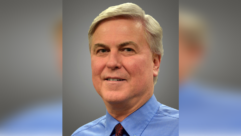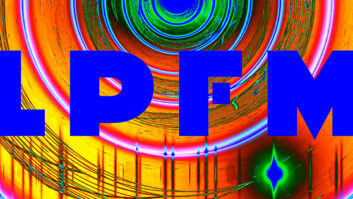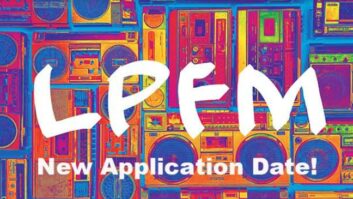WASHNGTON — Should the FCC allow stations to increase HD Radio power “asymmetrically”?
If it does, as many observers expect, the change would come at what could be an important juncture for U.S. digital radio.
In a separate but related development, iBiquity Digital, Intel, Emmis Communications and BIA/Kelsey, backed by NAB funding, have collaborated on a prototype cellphone with an enabled FM HD Radio chip. It will be demoed at the NAB Show.
But to persuade wireless carriers to build such mobile devices, proponents feel stations need more flexibility to raise digital power — to support advanced data features afforded by digital radio technology, including transmission of visual images synched with audio. Higher power also would allow digital coverage to better match that of analog FM, seen as critical to the effort to encourage HD FM chips in mobile devices.
The commission asked for comments on asymmetric recent field trials as well as the process by which FMs would notify the commission they have increased power unevenly. Seven comments were filed, from 11 broadcast entities, four equipment manufacturers, iBiquity Digital and NAB. Six reply comments had ensued by the end of January. All were favorable but one.
Excerpts:
SUPPORT ASYMMETRICAL SIDEBAND POWER RISE
Several executives contributed to a filing by the National Association of Broadcasters. Executive Vice President of Legal and Regulatory Affairs Jane Mago headed the list:
NAB supports the request by iBiquity Digital Corp. and National Public Radio for authority for FM stations to operate with asymmetric digital power. Permitting such operations will enable many digital FM stations to increase power in a single digital sideband and thus improve their digital radio service without causing interference to adjacent stations. …

An iBiquity chart summarizes the increase in total digital power for various sideband configurations compared to the legacy configuration of –20 dBc with symmetric sidebands. Ideally, the improvement in digital SNR should track this increase so that, for example, in the case where lower sideband (LSB) power is set to –23 dBc, upper sideband power (USB) is set to –17 dBc and total increased digital power is 3.96 dB, the expected improvement in digital SNR would also be 3.96 dB.
In many areas today, increasing digital power by 10 dB (or less) would potentially cause interference to a first-adjacent signal on only one side of the subject station’s signal (operating on either the upper or lower first-adjacent channel), so the full potential digital power increase on the opposite (non-limiting) side cannot be achieved. This unnecessary digital power limitation is especially harmful to listeners of multicast (i.e., HD2, HD3, etc.) channels, where, in digital drop-off areas, the multicast channel completely drops out (mutes), rather than blending to the analog signal as the digital signal does for the main channel.
Now, iBiquity and NPR have demonstrated in their studies that digital coverage can be improved with asymmetric sideband operation, increasing power up to the already authorized 10 dB level in one digital sideband, where interference is not a concern, while protecting reception of a vulnerable first-adjacent station that may be potentially impacted by increasing the power in the other digital sideband.
These reports demonstrate that asymmetric sideband operation can enable incremental but significant improvements in digital radio coverage, particularly by filling in drop-out areas that can disrupt service to listeners in mobile (automobile) environments. Increasing the power in a single digital sideband also should improve reception inside buildings and enhance the performance of portable radios and other handheld devices.
IT HELPS AVOID INTERFERENCE
Crawford Broadcasting Director of Engineering W.C. “Cris” Alexander (who is also an RW contributor), wrote:
For a number of years, Crawford Broadcasting Co. affiliate stations have operated employing HD Radio technology on both AM and FM. During this time, we have dealt with different degrees of interference, particularly in short-spaced or “rim-shot” situations that could have been helped by the application of asymmetrical sideband operation.
At KBRT(AM) in Avalon, Calif., a case of HD digital carrier interference to second-adjacent channel KFMB(AM) in San Diego was eliminated by reduction in power to the KBRT upper digital carrier levels.
Another case, also with KBRT, was cured when third-adjacent channel KSPN(AM) in Los Angeles made a 2 dB reduction in its upper HD Radio digital carrier levels, thereby eliminating significant third-order IM products that were overriding KBRT within the KBRT 5 mV/m contour. In both cases, HD Radio coverage continues to be more than acceptable.
Based on these two empirical examples alone, we believe that asymmetrical sideband operation can also be applied to FM HD Radio signals to eliminate interference and perhaps accommodate digital power increases in some situations. This amounts to a more efficient utilization of spectrum.
DENY THE REQUEST
Jonathan Hardis has attended NRSC meetings to represent the National Institute of Standards and Technology. He writes here as an individual:
The order [authorizing the power increase in 2010]was predicated on a mistaken belief that IBOC digital sidebands, even those as powerful as –10 dBc, comply with the commission’s FM emissions mask … § 73.317 requires that, “Any emission appearing on a frequency removed from the carrier by between 120 kHz and 240 kHz inclusive must be attenuated at least 25 dB below the level of the un-modulated carrier.”§ 73.317. The orderallowed powers as great as –10 dBc, which is 15 dB greater than that allowed by § 73.317. “15 dB greater” means 31.6 times the allowed power. This premise is manifestly untrue. In relevant part, IBOC digital sidebands are removed from the carrier by 129 kHz to 198 kHz, which falls within the range specified by this rule. However, the 2002 standard for digital power was –20 dBc, which is 5 dB greater than that allowed by than that allowed by § 73.317. “15 dB greater” means 31.6 times the allowed power. …
The instant request to have asymmetric sideband power in excess of –20 dBc should be denied for the same reasons that symmetric sideband power in excess of –20 dBc should be denied: These power levels exceed the commission’s FM emissions mask as given in § 73.317 of the commission’s rules and they create harmful interference to the incumbent FM broadcast service. Further, as explained in detail in my Application for Review, allowing broadcast powers in excess of –20 dBc (or –23 dBc per sideband) constitutes allocation of new spectrum. …
Background
The agency is reviewing public comments on the asymmetrical power increase question, and the National Radio Systems Committee recently submitted a revised IBOC technical standard, NRSC-5-C, for the agency to incorporate into its technical rules. Some observers believe the FCC will approve the change relatively soon.
In January 2010, the FCC allowed most FM HD stations to increase digital power voluntarily by up to –6 dB, to 14 dB below carrier. Some can go up to 10 dB below carrier, depending on distance separations from first-adjacent stations. The symmetric increase allowed digital FMs to replicate analog service more closely, in terms of geographic coverage area and building penetration. Since May 2010, stations may raise digital power and simply tell the commission via notification letter.
As of March of last year, some 1,627 FMs were transmitting digital; of those, about 225 had raised digital power, most of which were operating at –14 dBc. A year later the number of FMs transmitting HD Radio has increased to 1,708, according to the FCC. However the commission database does not readily distinguish between notifications of various power levels.
Based on a sample of notifications, the Media Bureau estimated for Radio World that 361 FMs now are operating with increased digital power, with most implementing a 6 dB increase, operating at –14 dBc.
“A significant number of FMs” can’t increase HD power levels by a full 10 dB because of potential interference to nearby stations on first-adjacent channels, the FCC stated in November when it invited comments. “If asymmetric digital sideband operation is permitted, such stations presumably could increase their digital power on the sideband away from the limiting station.”
IBiquity Digital and NPR asked for the change and submitted field test data; they say asymmetrical sideband transmission can improve an FM station’s digital coverage without causing interference.
Right now, stations that want to use asymmetrical transmission need experimental authorization. Only one had been granted as of early March; a second request was pending, according to the agency.
The commission tentatively has decided to modify Form FCC 335-FM, used for digital notifications, to accommodate requests for increased digital power and/or operation with asymmetric digital sideband power.
— Leslie Stimson
Rather than focusing on individual elements, such as digital sideband power, the commission should seek to finalize the standard as a whole. …
AVOID ‘POT-LUCK’ TECH STANDARDS
Reply comments by broadcast engineering consulting engineering firm Cohen, Dippell and Everist P.C., submitted by Donald G. Everist.
This firm polled a number of its clients … Of those who responded (several responded with no opinion) [several] were, in general, in favor of adoption of asymmetrical FM IBOC as a permissive operation so long as there was no actual off-the-air interference to current listeners. …
The commission is once again placed in the position of balancing possible interference to existing off-the-air reception from the introduction of a new service.
This observation leads to the specific comments by Jonathan E. Hardis.
His comments are well written and thoughtful. It is a reminder to the industry as a whole that pot-luck adoption of technical standards for a new public service should be discouraged. It is recognized that in this era of technical change and offerings to the public that there needs to be a technical foundation if it is to be effectively administered by the commission in a sound regulatory manner.
OVERPOWERED CLAIMS ARE INCORRECT
Several people signed a response representing nine radio groups, four equipment manufacturers and a consulting engineer. They are Beasley Broadcast Group VP of Engineering/CTO Mike Cooney; Harris Broadcast VP Transmission Research & Technology Geoffrey Mendenhall; Broadcast Electronics VP RF Engineering Brian Lindemann; Journal Broadcast Group VP/CTO Andrew Laird; CBS Radio SVP Engineering E. Glynn Walden; Lincoln Financial Media Co. VP Engineering Barry Thomas; Clear Channel Communications EVP Engineering & Systems Integration Jeff Littlejohn; Nautel Ltd. Head of Engineering Tim Hardy; Continental Electronics Corp. President Dan Dickey; Radio One Acting VP Corporate Engineering John Soller; Greater Media VP Radio Engineering Milford Smith; and Warmus and Associates VP Roy Stype, also representing Carl E. Smith Consulting Engineers.
Mr. Hardis’ claims are based on an incorrect reading of PM emissions mask requirements, as set forth in Section 73.317 of the commission’s rules. Specifically, the engineering statement demonstrates that Mr. Hardis has incorrectly attempted to reinterpret the FM emissions mask rule as applying to a set of aggregated, multiple emissions within a particular bandwidth.
However, rather than measuring the aggregated channels removed from the relevant carrier by between 120 kHz and 240 kHz, the FM emissions mask is properly applied to “any emission” in that frequency. As a result, contrary to Mr. Hardis’ assertion, the joint parties were correct to state that HD Radio operation at the –10 dB power level comply with the commission’s FM emissions mask. The accuracy of the interpretation advanced by the joint parties is reflected by the historical practice of the FCC and the broadcast engineering community. …
The filings made in this proceeding by Jonathan E. Hardis reimagine Section 73.317 by using Total Power Spectral Density (PSD) as the basis of his arguments. Under his interpretation of this rule, Hardis contends that the IBOC power is 5 dB higher than the –25 dBc mask. However, the traditional understanding and practice of the FCC and broadcast engineering community has been to treat each spurious emission as a separate entity with each IBOC carrier, as defined by the iBiquity specification, to be at –45.8 dBc or 20.8 dB below the mask.
THE QUESTION HAS INDUSTRY CONSENSUS
IBiquity Digital Corp. wrote:
The comments demonstrate a broad industry consensus that the use of asymmetric sidebands will allow broadcasters to enhance their digital service and that the FCC should authorize this mode of operation. The National Association of Broadcasters, National Public Radio, Nautel Maine Inc., Crawford Broadcasting Co. and a coalition of companies operating more than 315 commercial radio stations and equipment manufacturers all offered unqualified support for the asymmetric sideband proposal. …
The Hardis comments reflect Mr. Hardis’ longstanding opposition to all aspects of IBOC technology rather than any valid criticism of the asymmetric sideband proposal. The comments of a single individual relying on a misreading of the commission’s rules and the information in this docket should not stand in the way of advancing a sound technical proposal with unanimous industry support.
First, the Hardis comments assert that iBiquity’s power measurement methodology misstates digital power and that IBOC transmissions at power levels above –20 dBc violate Section 73.317 of the commission’s rules. Second, the Hardis comments take issue with current industry practice, which does not include extended hybrid carriers when calculating digital power. In both cases, the IBOC operations in use throughout the radio industry comply with the commission’s rules and good technical practices that broadcasters have endorsed through open industry standards setting activity. Mr. Hardis’ concerns should be dismissed.












